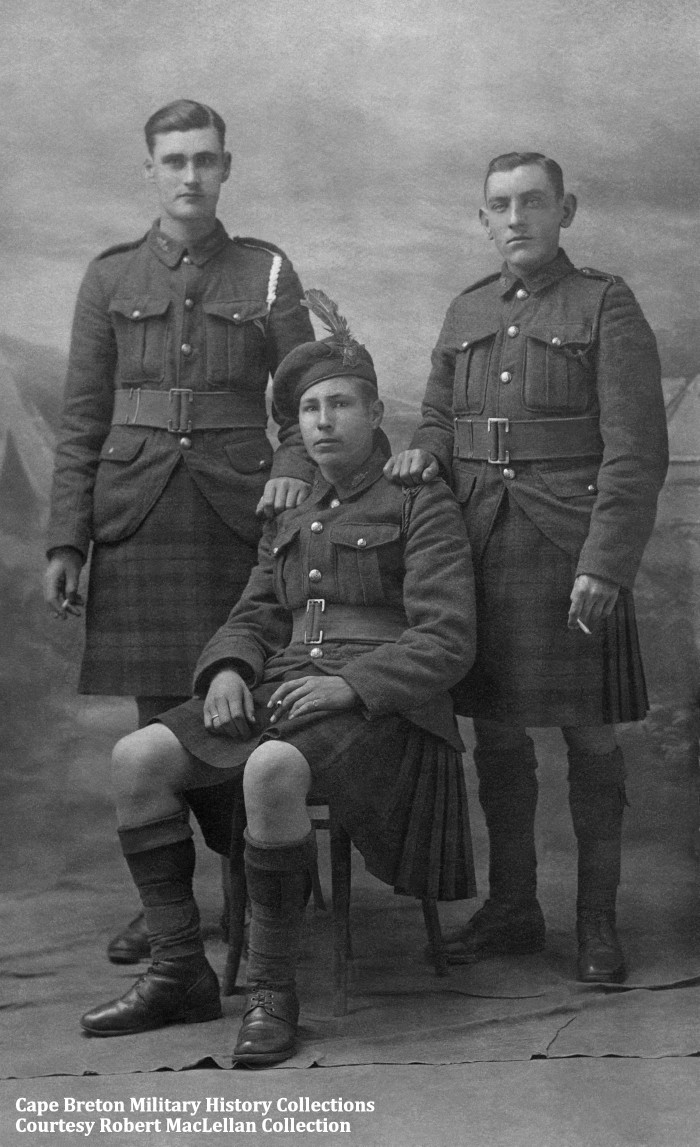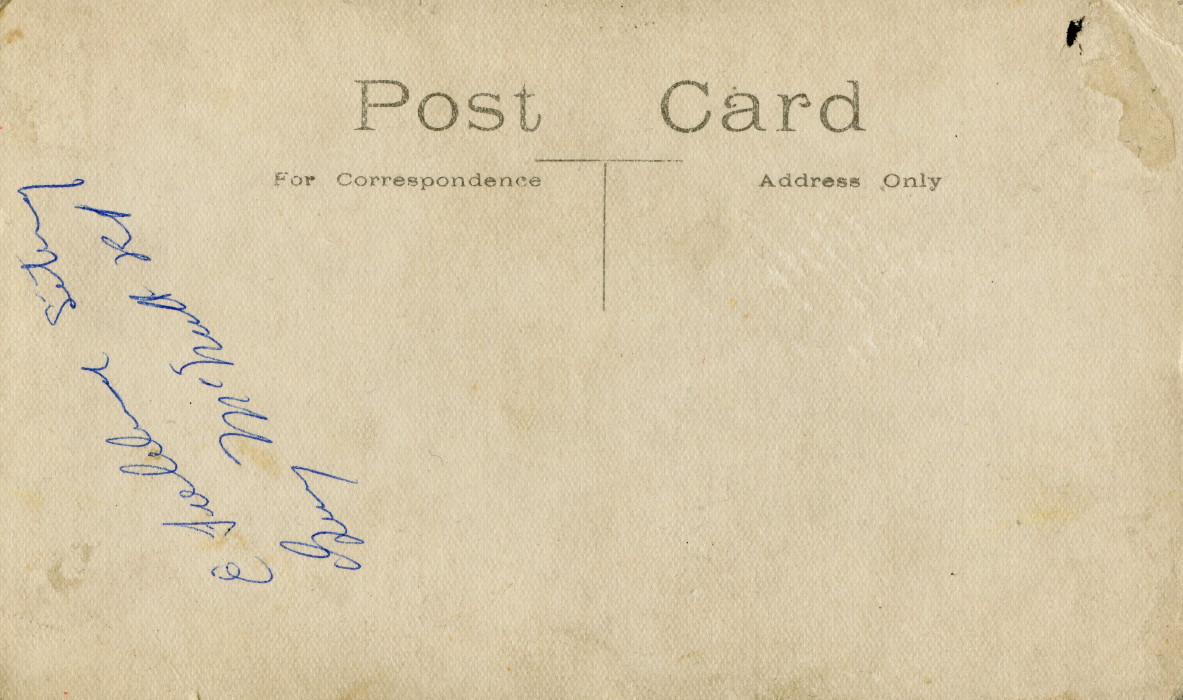Theme Collections
185th Battalion (Cape Breton Highlanders) CEF
Studio Portrait Photos and Personal Profiles - First World War
Photo Postcard
One studio portrait photo postcard of three soldiers of the 185th Battalion, England, circa 1917. Two are identified - Pte. Edwin Fielding and Pte. Guy Lewis McNutt.
Click or tap on the images below for high resolution, expandable images. Use your back button to return to this page.
Three Soldiers
185th Battalion (Cape Breton Highlanders)
England
Circa 1917
Three soldiers from the 185th Battalion pose for a studio photo. The man on the left is unidentified. The man on the right is Pte. Guy Lewis McNutt from Truro, NS. In the centre is Pte. Edwin Oliver Fielding, also from Truro. The men wear kilts but are missing their sporrans. Two are missing their caps. Note they are all holding cigarettes. See below for detailed information on the two named men.
Pte. McNutt was married to Pte. Fielding's sister.
Photographer: Unknown
Ref. Number: 0-4 (2-1-4-1.3)
Image Information: Scan of original photo postcard
Source: Robert MacLellan Collection
_________________________________________
Short Biography and Record of Service
Pte. Guy Lewis McNutt
Service Number 901210
Killed in Action August 10, 1918
85th Battalion (Nova Scotia Highlanders)
Guy Lewis McNutt was born in Truro, NS, on August 3, 1896, the son of Elisha and Elizabeth “Eliza” (Joudrey) McNutt. He grew up in Truro and became a cap maker. On March 14, 1916, he enlisted as a private in the 193rd Battalion (Nova Scotia Highlanders) in Truro.
At the time of his enlistment, the 193rd Battalion was headquartered in Truro. Two months later, the battalion relocated to the large pre-war military training camp at Aldershot, NS, where they united with their three sister battalions of the newly formed Nova Scotia Highland Brigade. The four battalions trained together at Aldershot throughout the summer and early fall. On September 5, 1916, during his training at Aldershot, Guy married Violet Luerita Fielding. A month later, the whole brigade entrained for Halifax, where they boarded the troopship RMS Olympic, sister ship of the Titanic, and on October 13, 1916, set sail for England.
After disembarking in England, the men were established at Witley Camp in southern England. Word soon arrived that the Nova Scotia Highland Brigade would be dissolved. Two of the battalions, including Guy’s 193rd Battalion, were to be broken up with the men to be used for reinforcements for other Canadian units. As a result, on December 29, 1916, Guy was transferred to the 185th Battalion (Cape Breton Highlanders) who were also at Witley Camp. The battalion was one of the four battalions of the former Nova Scotia Highland Brigade and were still earmarked to cross the channel as a unit. The 185th Battalion trained in England throughout 1917 but in early 1918, they were also ordered to be disbanded to provide badly needed reinforcements for Canadian units already at the front.
On March 1, 1918, Guy proceeded across the English Channel to France as a reinforcement for the 85th Battalion (Nova Scotia Highlanders). He joined his new unit in the field three days later. By that time, the 85th Battalion had been at the front for just over a year.
On August 8, 1918, the 85th Battalion began an attack in the Amiens sector, a part of a major Allied push to capture the French city of Amiens, a major logistics centre. Over the next several days, the 85th Battalion fought the Germans over control of several villages to the east of Amiens and took heavy casualties in officers and men. These actions became known as the Llandovery Castle operations after a German submarine torpedoed the Canadian hospital ship Llandovery Castle off the coast of Ireland on June 27, 1918. The sinking and subsequent machine gunning of survivors killed 234 members of the Canadian Army Medical Corps, soldiers and seamen. Guy McNutt was killed in action on August 10, 1918, during the course of this fighting. According to First World War Canadian Circumstances of Death Registers, he was struck in the head and instantly killed by an enemy machine gun bullet while his battalion was advancing southeast of the village of Rosieres-en-Santerre.
Guy McNutt was laid to rest in Fouquescourt British Cemetery near the small village of Fouquescourt, France. He was 22 years old.
_________________________________________
Short Biography and Record of Service
Pte. Edwin Oliver Fielding
Service Number 1060209
Edwin Oliver Fielding was born in Truro, NS, on April 27, 1899, the son of William Wilson and Marjorie Ellen (Bartlett) Fielding. On November 22, 1916, at the age of 17, he enlisted as a private in the 246th Battalion (Nova Scotia Highlanders), a reserve battalion for the Nova Scotia Highland Brigade. The 246th Battalion was headquartered in Halifax and later moved to Camp Aldershot, the large prewar military training ground in Aldershot, NS. The 246th Battalion sent two drafts overseas in 1917. Edwin was in the first draft that sailed from Halifax on the RMS Olympic, sister ship of the Titanic, on June 2, 1917.
Upon arrival in England, Edwin was transferred to the 185th Battalion (Cape Breton Highlanders) who were training at Witley Camp in southern England. In early 1918, the 185th Battalion was ordered to be disbanded to provide badly needed reinforcements for Canadian units at the front. As a result, on January 16, 1918, Edwin was posted to the Nova Scotia Regiment Depot and then to the 17th Reserve Battalion on March 1, 1918. On May 7, 1918, Edwin crossed the English Channel to France as a reinforcement for the 85th Battalion (Nova Scotia Highlanders). He joined them in the field a month later. The 85th Battalion had been in France since February, 1917.
In September, 1918, the 85th Battalion was involved in an assault that was part of the Cambrai operations, a general attack on Cambrai and St. Quentin through a section of the Hindenburg Line. On September 29, 1918, the battalion was involved in heavy fighting around a railway in the vicinity of the villages of Sancourt and Blecourt. There were many casualties. It was during the fighting on this day that Edwin was hit in the right thigh which caused a compound fracture of his femur. He was evacuated from the lines and sent back to England for recovery. He spent time there in hospitals before being invalided back to Canada in April, 1919. He was treated at Camp Hill Hospital in Halifax and was discharged from the army on June 6, 1919 as medically unfit.
After the war, Edwin settled in Truro and in 1924 married Mary Lydia Bennicke. Edwin passed away on June 1, 1968 in Truro at the age of 66. He was laid to rest in Watson Cemetery in Salmon River, Colchester County, NS.
In researching Edwin Fielding’s history, there appears to be some discrepancy on his age. His military service files list his date of birth as April 27, 1899 which put him at 17 years old when he enlisted. This was very young but certainly not uncommon. Although the Fielding family does not appear to be listed in earlier census data, the family is listed in the 1921 census. Edwin is recorded as living at home with his parents with his age listed as 20 years old. This would put his date of birth as 1901 or 1902. On the Find a Grave website, Edwin’s date of birth is listed as April 27, 1902 and his headstone also indicates his date of birth as 1902. If this is correct, Edwin may have been as young as 14 when he enlisted.

